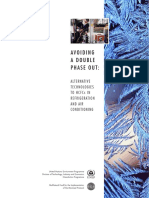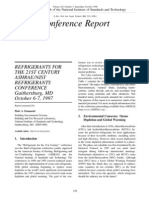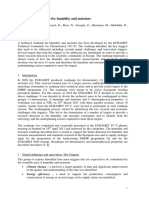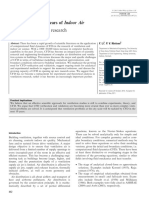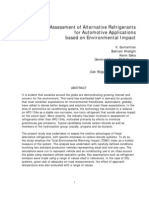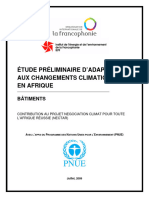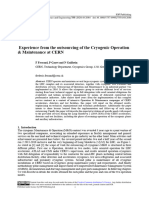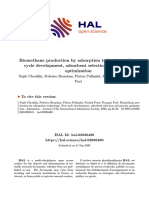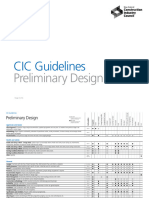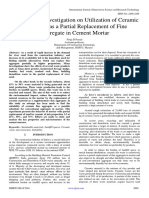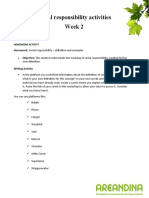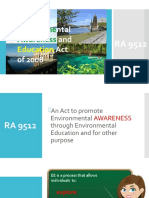Professional Documents
Culture Documents
Assessment On The Level of Implementation of CFCs and HCFCs Montreal Protocol by Refrigeration and Air-Conditioning Practitioners in Benue State, Nigeria
Original Title
Copyright
Available Formats
Share this document
Did you find this document useful?
Is this content inappropriate?
Report this DocumentCopyright:
Available Formats
Assessment On The Level of Implementation of CFCs and HCFCs Montreal Protocol by Refrigeration and Air-Conditioning Practitioners in Benue State, Nigeria
Copyright:
Available Formats
Volume 8, Issue 5, May – 2023 International Journal of Innovative Science and Research Technology
ISSN No:-2456-2165
Assessment on the Level of Implementation of CFCs
and HCFCs Montreal Protocol by Refrigeration and
Air-conditioning Practitioners in Benue State, Nigeria
1
Tyav, Alfred Demenongu, 2 Tar, Sesugh Solomon, 3Agu, Peter Ashlame
1 &2
Department of Vocational and Technical Education, Benue State University, Makurdi, Nigeria
3
Department of Science, Technology and Mathematics Education, Nassarawa State University, Keffi, Nigeria.
Abstract:- This study assessed the level of implementation 7), Non-compliance (Article 8), Technical assistance (Article
of CFCs and HCFCs Montreal Protocol by Refrigeration 10), as well as other topics [4]. The substances controlled by
and Air conditioning practitioners in Benue State. The the treaty are listed in Annexes A (CFCs, halons), B (other
population of the study comprised of 50 practitioners of fully halogenated CFCs, carbon tetrachloride, methyl
refrigeration and air conditioning across the state. A chloroform), C (HCFCs), E (methyl bromide) and F (HFCs).
descriptive survey research design was used for the study. Throughout the implementation of the Montreal Protocol,
The instrument for data collection was a structured developing countries have demonstrated that, with the right
questionnaire and data collected was analyzed using kind of assistance, they are willing, ready and able to be full
descriptive statistics to ascertain the extent to which partners in global efforts to protect the environment. In fact,
practitioners in Benue State have implemented CFCs and many developing countries have exceeded the reduction
HCFCs Montreal protocol. The result of the study targets for phasing out ODS, with the support of the
revealed that refrigeration and air conditioning Multilateral Fund [6]. Montreal Protocol on substances that
practitioners in Benue State are aware of CFCs and deplete the ozone layer has developed a phase-out
HCFCs effect on Ozone layer depletion but they are not management plan which includes both production and
able to recover and store CFC and HCFC Refrigerants consumption of chlorofluorocarbons (CFCs) and hydro-
from old refrigerating systems when carrying out repairs. chlorofluorocarbons (HCFCs) [5].
The study recommended among others that refresher
trainings should be organized for practitioners. The conversion of equipment and recovery of
refrigeration and air conditioning systems using CFCs and
Keywords:- Refrigeration and Air conditioning; HCFCs has not yet been completed; such systems when
Practitioners; Montreal Protocol; Refrigerants. spoiled are left in the hands of technicians for repairs.
Technicians are then required to handle such systems in
I. INTRODUCTION accordance with the Montreal protocol. This study is focused
on the level of implementation of Montreal Protocol by
Human activities since the Industrial Revolution are refrigeration and air conditioning practitioners in Benue State.
accountable for steady rises in atmospheric concentrations of
numerous greenhouse gases, particularly carbon dioxide and II. STATEMENT OF THE PROBLEM
organic chemicals such as chlorofluorocarbons (CFCs) and
hydro chlorofluorocarbons (HCFCs). CFCs and HCFCs are Nigeria is not an exception to the global regime for
refrigerants used in refrigeration and air conditioning systems; environmental protection of the ozone layer and in order to
and they are Ozone Depleting Substances (ODS) [1]. implement the Montreal Protocol, the Federal Government of
Chlorofluorocarbons are refrigerants that contain chlorine. Nigeria through the ministry of environment partner with
They have been banned since the beginning of the 90's United Nations Development Program (UNDP) through a
because of their negative environmental impacts [2]. The project managed by the Ozone Program and Management
hydrofluorocarbons are refrigerants that contain no chlorine Implementation Unit (OPIAMU) for awareness creation and
and are not harmful to the ozone layer however; their impact training of industrial operators that are concerned with CFCs
on global warming is very large (Mann, 2019). and HCFCs substances. One of the major operators that
handle such substances is the refrigeration and air
According to UNEP[3], The Montreal Protocol entered conditioning practitioners; these practitioners are the craft
into force on 1 January 1989 and has since undergone nine men, technician, technologist and engineers who carry out
revisions; in 1990 (London), 1991 (Nairobi), 1992 repairs, maintenance or handle installation of refrigeration and
(Copenhagen), 1993 (Bangkok), 1995 (Vienna), 1997 air conditioning equipment, they are directly involved in
(Montreal), 1998 (Australia), 1999 (Beijing) and 2016 handling refrigerants that contains CFCs and HCFCs
(Kigali). The Protocol includes provisions related to Control substance. In the year 2008, Refrigeration and Air-
Measures (Article 2), Calculation of control levels (Article 3), conditioners practitioners in Benue State were trained on
Control of trade with non-Parties (Article 4), Special situation proper handling of these substances and hence there is a need
of developing countries (Article 5), Reporting of data (Article to assess the level of implementation on the handling of these
IJISRT23MAY931 www.ijisrt.com 1535
Volume 8, Issue 5, May – 2023 International Journal of Innovative Science and Research Technology
ISSN No:-2456-2165
substances by the practitioners of the refrigeration and air refrigerants from old systems; Part “C” 5 items on
conditioning in Benue State. practitioners ability to store CFCs and HCFCs refrigerants
recovered from old systems for proper disposal; and Part “D”
III. RESEARCH QUESTIONS has 5 items on practitioners release of CFCs and HCFCs
refrigerants in old systems to the atmosphere during repairs. A
The following research questions were formulated to five-point response mode of Strongly Agreed (SA), Agreed
guide the study: (A), Strongly Disagree (SD), Disagree (D), and Undecided
Are the refrigeration and air conditioning practitioners in (UD) with a corresponding numerical response scale value of
Benue State aware of CFCs and HCFCs refrigerants' effect 5, 4, 3, 2 and 1 was used to illicit information from the
on Ozone layer depletion? practitioners. The questionnaire items were validated by two
Are the refrigeration and air conditioning practitioners in experts of refrigeration and air conditioning from the
Benue State able to recover CFCs and HCFCs refrigerants department of vocational and technical education, Benue State
from old systems? University, Makrudi.
Are the refrigeration and air conditioning practitioners in
Benue State able to store CFCs and HCFCs refrigerants Data collected from the practitioners were analyzed
recovered from old systems for proper disposal? using mean and standard deviation. The cut off point for
taking decision on each item was 3.00. Any item representing
IV. METHODOLOGY a task whose mean was less than 3.00 was regarded as not
able to perform the task.
The study adopted a descriptive research design in which
information relating to the level of implementation of CFCs V. RESULTS
and HCFCs Montreal Protocol by Refrigeration and Air-
conditioning practitioners in Benue State was sought. Fifty The results are presented according to the research
(50) practitioners were sampled from a population of three questions that guided the study.
hundred (300) practitioners in Benue State. The instrument for
data collection was a structured interview questionnaire and Research Question 1: Are the refrigeration and air
the questionnaire items were structured into four parts (A, B, conditioning practitioners in Benue State aware of CFCs
C, & D). Part “A” had 5 items on practitioners aware of CFCs and HCFCs refrigerants' effect on Ozone layer depletion?
and HCFCs effect on Ozone layer depletion; Part “B” 5 items The data that answer this research question is presented
on practitioners ability to recover CFCs and HCFCs in table 1 below.
Table 1Mean rating of refrigeration and air conditioning practitioners’ awareness of CFCs and HCFCs refrigerants' and its
effect on Ozone layer depletion.
Test Items N SA A D SD Ẋ STD
CFCs and HCFCs are the main Refrigerants Currently Used in refrigeration and 50 23 15 4 8 3.14 0.0190
Air-Conditioning services in Makurdi Metropolis.
The ozone layer is essential to the existence of lifeforms on earth. 50 35 13 2 3.66 0.0021
Ozone depletion can affects life forms on earth negatively. 50 31 14 3 3.48 0.0003
CFCs and HCFCs are substances that deplete the Ozone Layer and threaten the 50 42 6 2 3.80 0.0091
existence of life forms on earth.
CFCs and HCFCs Refrigerants have positive effects on the Ozone Layer. 50 2 3 2 25 3.36 0.0036
0
Releasing CFCs and HCFCs into the Atmosphere Causes Damage to the Ozone 50 38 7 4 1 3.64 0.0015
Layer.
CFCs and HCFCs refrigerants to are on the Phase out list of Montreal Protocol 50 29 15 3 3 3.40 0.0021
Cluster Mean 3.53 0.2195
Note: N = number of respondent, SA = Strongly Agreed, A=Agreed, D = Disagreed, SD = Strongly Disagreed, Ẋ = Mean and
STD = Standard Deviation
The data presented in Table 1 shows the mean rating of implies that they all agreed to the test items aware of CFCs
respondents with regards to awareness of CFCs and HCFCs and HCFCs effects on Ozone layer depletion. The cluster
and its effects on Ozone layer depletion. The data showed mean of 3.53 was also accepted since it met the cut-off point
that the mean rating of the respondents for test item 1, 2, 3, 4, condition. This implies that refrigeration and Air-
5, 6, and 7 are 3.14, 3.66, 3.48, 3.80, 3.82, 3.36, 3.64, and Conditioning practitioners in Benue State are aware of CFCs
3.40, respectively. On the basis of the cut-off point of 2.50, and HCFCs effect on Ozone layer depletion.
all the items indicated that their mean were above 2.50 which
IJISRT23MAY931 www.ijisrt.com 1536
Volume 8, Issue 5, May – 2023 International Journal of Innovative Science and Research Technology
ISSN No:-2456-2165
Research Question 2: Are the refrigeration and air conditioning practitioners in Benue State able to recover CFCs and HCFCs
refrigerants from old systems?
The data that answer this research question is presented in table 2 below.
Table 2 Mean Ratings of refrigeration and Air-Conditioning practitioners in Benue State’s ability to recover CFCs and HCFCs
refrigerants from old systems
Test Items N SA A D SD Ẋ STD
I am able to recover CFCs and HCFCs Refrigerants from Old systems. 50 2 3 7 38 2.14 0.0190
I use recovery pump to recover CFCs and HCFCs Refrigerants from Old Systems. 50 2 1 6 41 2.23 0.0021
I observe safety procedures when recovering CFCs and HCFCs Refrigerants from 50 2 3 8 37 2.13 0.0091
old systems.
The procedures I recover CFCs and HCFCs Refrigerants is in line with Montreal 50 2 3 12 31 2.00 0.0003
Prototocol
Cluster Mean 2.14 0.0012
Note: N = number of respondent, SA = Strongly Agreed, A=Agreed, D = Disagreed, SD = Strongly Disagreed, Ẋ = Mean and
STD = Standard Deviation
Data presented in table 2 shows the mean ratings of refrigeration and air conditioning practitioners in Benue State
respondents with regards to refrigeration and Air- are not able to recover CFCs and HCFCs from old systems.
Conditioning practitioner’s ability to recover CFCs and
HCFCs from old systems. The table revealed that the mean Research Question 3: Are the refrigeration and air
rating for respondents for test item 1 to 4 fails the cut-off conditioning practitioners in Benue State able to store
point of 2.50; all the items indicated a mean below 2.50 which CFCs and HCFCs refrigerants recovered from old
implies they were all rejected as the refrigeration and air- systems for proper disposal?
conditioning practitioners in Benue State are not able to The data that answer this research question is presented
recover CFCs and HCFCs from old systems. This implies that in table 3 below.
Table 3 Mean Ratings of refrigeration and Air-Conditioning practitioners’ ability to store CFCs and HCFCs refrigerant recovered
from old systems for proper disposal.
Test Items N SA A D SD Ẋ STD
After I Recover CFCs and HCFCs Refrigerants from Old Systems, I 50 2 3 10 35 2.00 0.0006
store in Safety cylinders
I hand over recovered CFCs and HCFCs refrigerants to ministry of 50 2 1 4 43 1.90 0.0001
environment for proper disposal.
I stored recovered CFCs and HCFCs Refrigerants cylinders in a well- 50 2 3 8 37 2.13 0.0004
ventilated room.
I do not release CFCs and HCFCs Refrigerants to the atmosphere during 50 2 3 12 31 2.00 0.0003
repairs of refrigeration systems.
Cluster Mean 2.02 0.0025
Note: N = number of respondent, SA = Strongly Agreed, A=Agreed, D = Disagreed, SD = Strongly Disagreed, Ẋ = Mean and
STD = Standard Deviation
The data in table 3 shows the mean ratings of and ozone layer depletion but they lack knowledge to handle
refrigeration and Air-Conditioning practitioners’ ability to such refrigerants.
store CFCs and HCFCs recovered from old systems for
proper disposal. The Table revealed that the mean rating of The cluster mean of 2.14in table was rejected since it
the respondents for test item 1to 4 fails the cut-off point of not met the specified condition of 2.50. This implies that
2.50, all the items indicated that their mean are below 2.50 refrigeration and air conditioning practitioners in Benue State
which implies refrigeration and air-conditioning practitioners are not able to recover CFCs and HCFCs from old systems.
in Benue State are not able to store recovered CFCs and This also shows that montreal protocol on recovery and
HCFCs refrigerant from old systems for proper disposal. handling of CFCs and HCFCs refrigerants has not been
implemented by the practitioners in the state.
VI. FINDINGS
VII. CONCLUSION
The findings from the analysis shows that the Montreal
protocol to phase out the use of Ozone depleting substances Refrigeration and Air conditioning Practitioners in
such as CFCs and HCFCs have not been implemented by Benue State have not implemented the Montreal Protocol on
refrigeration and air-conditioning Practitioners in Benue CFCs and HCFCs refrigerants to a very great extent that they
State, Nigeria. Practitioners in this specialty are aware of the do not recover or store the refrigerants from old refrigeration
dangers of CFCs and HCFCs refrigerant to global warming systems during repairs.
IJISRT23MAY931 www.ijisrt.com 1537
Volume 8, Issue 5, May – 2023 International Journal of Innovative Science and Research Technology
ISSN No:-2456-2165
RECOMMENDATIONS
Based on the findings of this study, the following
recommendations were made:
Workshops and trainings should be organized yearly by
the government and related stakeholders for refrigeration
and air-conditioning practitioners as they are directly
involved in handling of refrigerants that contain CFCs
and HCFCs substance.
The Government should set-up bodies that will carry out
routine checks, supervision and regulate the activities of
refrigeration and air-conditioning practitioners comply
with Montreal Protocol on CFCs and HCFCs.
REFERENCES
[1]. T. Sivasakthivel, K.K.Siva Kumar. ‘‘Ozone Layer
Depletion and Its Effects: AReview’’ International
Journal of Environmental Science and Development,
Vol.2, No.1, February 2011
[2]. Norouzi N, Talebi S., & Shahbazi A. ‘‘An overview on
the carbon capture technologies with an approach of
green coal production study’’ Chemical Review and
Letters (CRL) ISSN (online) 2645-4947
[3]. United Nations Environment Programme (UNEP)
Training Programme 2020 www.unep-wcmc.org
[4]. Andelin and John, “Analysis of the Montreal
Protocol,” Staff report, U.S. Congress, Office of
Technology Assessment, Jan. 13, 1988.
[5]. Angell, J. K. “The Variations in Global Total Ozone
and North emperate Layer Mean Ozone.” Journal of
Applied Meteorology, vol.27, no. 1, pp. 91–97, 2007.
[6]. Wachowski L, Kirszensztejn P, Foltynowicz Z.
‘‘Ecological replacements of ozone-depleting
substances’ Pol. J. Environ. Stud. 2001;10(6):415–435
IJISRT23MAY931 www.ijisrt.com 1538
You might also like
- Low Cost Options For The Use of Hydrocarbons in The Manufacture of Polyurethane FoamsDocument65 pagesLow Cost Options For The Use of Hydrocarbons in The Manufacture of Polyurethane FoamsMuhamad FadliNo ratings yet
- Ch#1 - SPE-126446-MS CO2 EOR Industry ApplicationDocument15 pagesCh#1 - SPE-126446-MS CO2 EOR Industry ApplicationMarcos RibeiroNo ratings yet
- Project Proposal - Clean-Up DriveDocument2 pagesProject Proposal - Clean-Up DriveRey Julius Villaverde100% (2)
- Combined Cooling, Heating and Power: Decision-Making, Design and OptimizationFrom EverandCombined Cooling, Heating and Power: Decision-Making, Design and OptimizationNo ratings yet
- Recovery & Recycling Systems Guidelines: Refrigeration SectorDocument93 pagesRecovery & Recycling Systems Guidelines: Refrigeration SectorMani KandanNo ratings yet
- Contaminated Land Remediation ReportDocument120 pagesContaminated Land Remediation ReportEmilia MAndrade100% (1)
- Clean Room HandbookDocument80 pagesClean Room HandbookPecingina Dalia DanielNo ratings yet
- Guidelines On The Destruction of CFCs in JapanDocument55 pagesGuidelines On The Destruction of CFCs in JapanBernyke ContracyNo ratings yet
- JOurnal of Cleaner ProductionDocument14 pagesJOurnal of Cleaner ProductionIvan HernándezNo ratings yet
- Analysis of Carbon Dioxide Capturing Technologies and Their Technology DevelopmentsDocument17 pagesAnalysis of Carbon Dioxide Capturing Technologies and Their Technology DevelopmentsMarceloValeriaNo ratings yet
- Part 1: Design, Modeling and Simulation of Post-Combustion CO Capture Systems Using Reactive SolventsDocument24 pagesPart 1: Design, Modeling and Simulation of Post-Combustion CO Capture Systems Using Reactive SolventsBenjamin F ZavalaNo ratings yet
- C r407c GuideDocument32 pagesC r407c Guidezam_ramliNo ratings yet
- 3030 eDocument58 pages3030 ecesar luis gonzalez rodriguezNo ratings yet
- EfedsdDocument82 pagesEfedsdGraciaVelitarioNo ratings yet
- Engg MGT StudyDocument42 pagesEngg MGT StudyAjayBravoNo ratings yet
- Standards For Evaluating Indoor AirDocument5 pagesStandards For Evaluating Indoor AirAgostinoNo ratings yet
- Development of A UAV Based Framework-2023Document28 pagesDevelopment of A UAV Based Framework-2023Nihal MNo ratings yet
- RR 204Document44 pagesRR 204ram27_rajiNo ratings yet
- Indoor Air Quality Assessment in An Office BuildinDocument9 pagesIndoor Air Quality Assessment in An Office BuildinDeva RajNo ratings yet
- Northwest Samar State University: Refrigeration TrainerDocument22 pagesNorthwest Samar State University: Refrigeration TrainerFamela GadNo ratings yet
- Jresv103n5p529 A1bDocument5 pagesJresv103n5p529 A1bramy86No ratings yet
- Refrigerants For Commercial Refrigerant Applications en Us 2884292Document20 pagesRefrigerants For Commercial Refrigerant Applications en Us 2884292JUAN RODRIGUEZNo ratings yet
- Chimiaadmin,+2003 0522Document7 pagesChimiaadmin,+2003 0522GaniyuNo ratings yet
- Carbon Capture Storage Research PaperDocument5 pagesCarbon Capture Storage Research Papergpnovecnd100% (1)
- A Comparative Study of A Front Opening Unified Pod F 2022 International JouDocument11 pagesA Comparative Study of A Front Opening Unified Pod F 2022 International JouAsmamaw FirewNo ratings yet
- European roadmap for humidity and moisture measurementsDocument5 pagesEuropean roadmap for humidity and moisture measurementsAdindra Vickar EgaNo ratings yet
- Carbon Dioxide As The Working Fluid in Heating And-Or Cooling SystemsDocument5 pagesCarbon Dioxide As The Working Fluid in Heating And-Or Cooling SystemsOnofreHalberNo ratings yet
- Carbon 04 00052Document19 pagesCarbon 04 00052Salome ValeriaNo ratings yet
- HVACDocument2 pagesHVACParesh GujaratiNo ratings yet
- Upgrade of The Co Direct Absorption Method For Low-Level C Liquid Scintillation CountingDocument8 pagesUpgrade of The Co Direct Absorption Method For Low-Level C Liquid Scintillation Countingandi tenriNo ratings yet
- CFD and Ventilation ResearchDocument12 pagesCFD and Ventilation ResearchBart Kemper, P.E.No ratings yet
- Alternate RefrigerantsDocument20 pagesAlternate RefrigerantsfareedfksNo ratings yet
- Sum Ant RanDocument26 pagesSum Ant RanSanju KumarNo ratings yet
- Carbon DioxideDocument62 pagesCarbon DioxideAndres GomezNo ratings yet
- Background Objectives SBSTA20Document29 pagesBackground Objectives SBSTA20RajabMumbeeNo ratings yet
- Indoor Air Quality Management Under Button Up ConditionsDocument11 pagesIndoor Air Quality Management Under Button Up ConditionsIJRASETPublicationsNo ratings yet
- Comparative Study of RefrigerantsDocument4 pagesComparative Study of RefrigerantsMayank KumarNo ratings yet
- 2022-Review-Progress in Adsorption Capacity of Nanomaterials For Carbon Dioxide Capture A Comparative StudyDocument80 pages2022-Review-Progress in Adsorption Capacity of Nanomaterials For Carbon Dioxide Capture A Comparative Studylas.chemicalNo ratings yet
- GXP PDFDocument32 pagesGXP PDFGayathri VelmuruganNo ratings yet
- Chemosphere: Chia Cheng Yang, Shu Hao Chang, Bao Zhen Hong, Kai Hsien Chi, Moo Been ChangDocument6 pagesChemosphere: Chia Cheng Yang, Shu Hao Chang, Bao Zhen Hong, Kai Hsien Chi, Moo Been ChangKuden NghichnguNo ratings yet
- Separations 08 00035 v2Document17 pagesSeparations 08 00035 v2Khánh Linh LêNo ratings yet
- Chemicaland: Department EngineeringDocument18 pagesChemicaland: Department EngineeringHemangi SharmaNo ratings yet
- Papakonstantinou2003Document8 pagesPapakonstantinou2003Carlos Luís JúniorNo ratings yet
- 325 OIF-IEPF BatimentsDocument76 pages325 OIF-IEPF BatimentsKévin SAVINo ratings yet
- Wijaksono_2022_IOP_Conf._Ser.__Earth_Environ._Sci._998_012034Document10 pagesWijaksono_2022_IOP_Conf._Ser.__Earth_Environ._Sci._998_012034Andrei Nicole De VeraNo ratings yet
- 1 s2.0 S0360132320302201 MainDocument10 pages1 s2.0 S0360132320302201 MainCarlos SilvaNo ratings yet
- United Nations Environment ProgrammeDocument19 pagesUnited Nations Environment ProgrammeFayaz AhamedNo ratings yet
- Carbon Monoxide Research PaperDocument4 pagesCarbon Monoxide Research Paperfvfmxb2y100% (1)
- Experience From the Outsourcing of the Cryogenic ODocument8 pagesExperience From the Outsourcing of the Cryogenic OPhilippe GayetNo ratings yet
- Tar Measurement in Biomass Gasification StandardisDocument169 pagesTar Measurement in Biomass Gasification StandardisJan AvNo ratings yet
- A Breakthrough in The Industrialization of Manufacturing Technology For New Mainstream Low GWP Refrigerants in ChinaDocument1 pageA Breakthrough in The Industrialization of Manufacturing Technology For New Mainstream Low GWP Refrigerants in ChinaJayakumar ANo ratings yet
- Air Quality DissertationDocument4 pagesAir Quality DissertationBuyCustomPapersOnlineChicago100% (1)
- Science of The Total EnvironmentDocument17 pagesScience of The Total EnvironmentAngelina GultomNo ratings yet
- Measurement of Air Exchange Rates in Di Fferent Indoor Environments Using Continuous CO SensorsDocument8 pagesMeasurement of Air Exchange Rates in Di Fferent Indoor Environments Using Continuous CO SensorsAnkur YashNo ratings yet
- Co2 Capture ThesisDocument4 pagesCo2 Capture Thesisreneejonesanchorage100% (1)
- mp30 Report Final 508v3Document19 pagesmp30 Report Final 508v3Rogelio Jr GabuyoNo ratings yet
- CO2 Utilization For Methanol Production Part IDocument13 pagesCO2 Utilization For Methanol Production Part Iguigoal2010No ratings yet
- Biomethane Production Optimization with Vacuum Pressure Swing AdsorptionDocument25 pagesBiomethane Production Optimization with Vacuum Pressure Swing Adsorptionumesh deshpandeNo ratings yet
- Leacock BLDG Indoor Quality Assess Feb2010Document36 pagesLeacock BLDG Indoor Quality Assess Feb2010Kaoru AmaneNo ratings yet
- Estimation of CO2 Emissions From IncineratorsDocument9 pagesEstimation of CO2 Emissions From IncineratorsMustafa AhmadNo ratings yet
- Visual Water: An Integration of App and Web to Understand Chemical ElementsDocument5 pagesVisual Water: An Integration of App and Web to Understand Chemical ElementsInternational Journal of Innovative Science and Research TechnologyNo ratings yet
- Parastomal Hernia: A Case Report, Repaired by Modified Laparascopic Sugarbaker TechniqueDocument2 pagesParastomal Hernia: A Case Report, Repaired by Modified Laparascopic Sugarbaker TechniqueInternational Journal of Innovative Science and Research TechnologyNo ratings yet
- Smart Cities: Boosting Economic Growth through Innovation and EfficiencyDocument19 pagesSmart Cities: Boosting Economic Growth through Innovation and EfficiencyInternational Journal of Innovative Science and Research TechnologyNo ratings yet
- Smart Health Care SystemDocument8 pagesSmart Health Care SystemInternational Journal of Innovative Science and Research TechnologyNo ratings yet
- Impact of Silver Nanoparticles Infused in Blood in a Stenosed Artery under the Effect of Magnetic Field Imp. of Silver Nano. Inf. in Blood in a Sten. Art. Under the Eff. of Mag. FieldDocument6 pagesImpact of Silver Nanoparticles Infused in Blood in a Stenosed Artery under the Effect of Magnetic Field Imp. of Silver Nano. Inf. in Blood in a Sten. Art. Under the Eff. of Mag. FieldInternational Journal of Innovative Science and Research TechnologyNo ratings yet
- Insights into Nipah Virus: A Review of Epidemiology, Pathogenesis, and Therapeutic AdvancesDocument8 pagesInsights into Nipah Virus: A Review of Epidemiology, Pathogenesis, and Therapeutic AdvancesInternational Journal of Innovative Science and Research TechnologyNo ratings yet
- An Analysis on Mental Health Issues among IndividualsDocument6 pagesAn Analysis on Mental Health Issues among IndividualsInternational Journal of Innovative Science and Research TechnologyNo ratings yet
- Implications of Adnexal Invasions in Primary Extramammary Paget’s Disease: A Systematic ReviewDocument6 pagesImplications of Adnexal Invasions in Primary Extramammary Paget’s Disease: A Systematic ReviewInternational Journal of Innovative Science and Research TechnologyNo ratings yet
- Compact and Wearable Ventilator System for Enhanced Patient CareDocument4 pagesCompact and Wearable Ventilator System for Enhanced Patient CareInternational Journal of Innovative Science and Research TechnologyNo ratings yet
- The Relationship between Teacher Reflective Practice and Students Engagement in the Public Elementary SchoolDocument31 pagesThe Relationship between Teacher Reflective Practice and Students Engagement in the Public Elementary SchoolInternational Journal of Innovative Science and Research TechnologyNo ratings yet
- Air Quality Index Prediction using Bi-LSTMDocument8 pagesAir Quality Index Prediction using Bi-LSTMInternational Journal of Innovative Science and Research TechnologyNo ratings yet
- Predict the Heart Attack Possibilities Using Machine LearningDocument2 pagesPredict the Heart Attack Possibilities Using Machine LearningInternational Journal of Innovative Science and Research TechnologyNo ratings yet
- The Utilization of Date Palm (Phoenix dactylifera) Leaf Fiber as a Main Component in Making an Improvised Water FilterDocument11 pagesThe Utilization of Date Palm (Phoenix dactylifera) Leaf Fiber as a Main Component in Making an Improvised Water FilterInternational Journal of Innovative Science and Research TechnologyNo ratings yet
- Parkinson’s Detection Using Voice Features and Spiral DrawingsDocument5 pagesParkinson’s Detection Using Voice Features and Spiral DrawingsInternational Journal of Innovative Science and Research TechnologyNo ratings yet
- Investigating Factors Influencing Employee Absenteeism: A Case Study of Secondary Schools in MuscatDocument16 pagesInvestigating Factors Influencing Employee Absenteeism: A Case Study of Secondary Schools in MuscatInternational Journal of Innovative Science and Research TechnologyNo ratings yet
- Harnessing Open Innovation for Translating Global Languages into Indian LanuagesDocument7 pagesHarnessing Open Innovation for Translating Global Languages into Indian LanuagesInternational Journal of Innovative Science and Research TechnologyNo ratings yet
- Exploring the Molecular Docking Interactions between the Polyherbal Formulation Ibadhychooranam and Human Aldose Reductase Enzyme as a Novel Approach for Investigating its Potential Efficacy in Management of CataractDocument7 pagesExploring the Molecular Docking Interactions between the Polyherbal Formulation Ibadhychooranam and Human Aldose Reductase Enzyme as a Novel Approach for Investigating its Potential Efficacy in Management of CataractInternational Journal of Innovative Science and Research TechnologyNo ratings yet
- Terracing as an Old-Style Scheme of Soil Water Preservation in Djingliya-Mandara Mountains- CameroonDocument14 pagesTerracing as an Old-Style Scheme of Soil Water Preservation in Djingliya-Mandara Mountains- CameroonInternational Journal of Innovative Science and Research TechnologyNo ratings yet
- Diabetic Retinopathy Stage Detection Using CNN and Inception V3Document9 pagesDiabetic Retinopathy Stage Detection Using CNN and Inception V3International Journal of Innovative Science and Research TechnologyNo ratings yet
- Dense Wavelength Division Multiplexing (DWDM) in IT Networks: A Leap Beyond Synchronous Digital Hierarchy (SDH)Document2 pagesDense Wavelength Division Multiplexing (DWDM) in IT Networks: A Leap Beyond Synchronous Digital Hierarchy (SDH)International Journal of Innovative Science and Research TechnologyNo ratings yet
- The Making of Object Recognition Eyeglasses for the Visually Impaired using Image AIDocument6 pagesThe Making of Object Recognition Eyeglasses for the Visually Impaired using Image AIInternational Journal of Innovative Science and Research TechnologyNo ratings yet
- Electro-Optics Properties of Intact Cocoa Beans based on Near Infrared TechnologyDocument7 pagesElectro-Optics Properties of Intact Cocoa Beans based on Near Infrared TechnologyInternational Journal of Innovative Science and Research TechnologyNo ratings yet
- Advancing Healthcare Predictions: Harnessing Machine Learning for Accurate Health Index PrognosisDocument8 pagesAdvancing Healthcare Predictions: Harnessing Machine Learning for Accurate Health Index PrognosisInternational Journal of Innovative Science and Research TechnologyNo ratings yet
- Design, Development and Evaluation of Methi-Shikakai Herbal ShampooDocument8 pagesDesign, Development and Evaluation of Methi-Shikakai Herbal ShampooInternational Journal of Innovative Science and Research Technology100% (3)
- Formulation and Evaluation of Poly Herbal Body ScrubDocument6 pagesFormulation and Evaluation of Poly Herbal Body ScrubInternational Journal of Innovative Science and Research TechnologyNo ratings yet
- The Impact of Digital Marketing Dimensions on Customer SatisfactionDocument6 pagesThe Impact of Digital Marketing Dimensions on Customer SatisfactionInternational Journal of Innovative Science and Research TechnologyNo ratings yet
- A Survey of the Plastic Waste used in Paving BlocksDocument4 pagesA Survey of the Plastic Waste used in Paving BlocksInternational Journal of Innovative Science and Research TechnologyNo ratings yet
- Comparatively Design and Analyze Elevated Rectangular Water Reservoir with and without Bracing for Different Stagging HeightDocument4 pagesComparatively Design and Analyze Elevated Rectangular Water Reservoir with and without Bracing for Different Stagging HeightInternational Journal of Innovative Science and Research TechnologyNo ratings yet
- Auto Encoder Driven Hybrid Pipelines for Image Deblurring using NAFNETDocument6 pagesAuto Encoder Driven Hybrid Pipelines for Image Deblurring using NAFNETInternational Journal of Innovative Science and Research TechnologyNo ratings yet
- Cyberbullying: Legal and Ethical Implications, Challenges and Opportunities for Policy DevelopmentDocument7 pagesCyberbullying: Legal and Ethical Implications, Challenges and Opportunities for Policy DevelopmentInternational Journal of Innovative Science and Research TechnologyNo ratings yet
- Corporate Social Responsibility Presentation1Document13 pagesCorporate Social Responsibility Presentation1Richard JuridicoNo ratings yet
- Green Marketing for Sustainable Green Tourism Conference PaperDocument11 pagesGreen Marketing for Sustainable Green Tourism Conference PaperSalwa SeragNo ratings yet
- CDMU Proposed ChangesDocument34 pagesCDMU Proposed ChangesJohanna Ferebee StillNo ratings yet
- WSOR Mar 2022 ReducedDocument66 pagesWSOR Mar 2022 ReducedThe Salt Lake TribuneNo ratings yet
- Presentation To MayantocDocument123 pagesPresentation To MayantocJonathan MaldupanaNo ratings yet
- Architecture and Biomimicry NotesDocument11 pagesArchitecture and Biomimicry NotesJbrRoNo ratings yet
- Modular Home Construction Systems for EthiopiaDocument2 pagesModular Home Construction Systems for EthiopiaImRekib Wouhib100% (2)
- Technical English Level 4 Progress Test 3 (Units 5-6) : Answer All The Questions. 1 Choose The Correct Option (A-D)Document5 pagesTechnical English Level 4 Progress Test 3 (Units 5-6) : Answer All The Questions. 1 Choose The Correct Option (A-D)fasdNo ratings yet
- Kreasi: Desain Bakery Dan Cafe Berkonsep Kekhasan Lokal PapuaDocument25 pagesKreasi: Desain Bakery Dan Cafe Berkonsep Kekhasan Lokal PapuaChairil anand sagaNo ratings yet
- Malaysian Sustainable Palm Oil Certification WorkshopDocument3 pagesMalaysian Sustainable Palm Oil Certification WorkshopStream LineNo ratings yet
- LLL g4.d Livrable 2 CSR 1922Document11 pagesLLL g4.d Livrable 2 CSR 1922Muhammed ArsNo ratings yet
- FILLED 4. NZCIC 2022 Preliminary Design 1Document8 pagesFILLED 4. NZCIC 2022 Preliminary Design 1ShankerNo ratings yet
- TugasanindividuDocument3 pagesTugasanindividuMuhammad Afif Danish Bin AzeliNo ratings yet
- Geo ss1Document1 pageGeo ss1NachyAloysiusNo ratings yet
- Dinesh Bhai OrderDocument3 pagesDinesh Bhai OrderNanda GroupNo ratings yet
- 2016 - Emerald - Younis, Sundarakani, Vel - CR-04-2015-0024Document33 pages2016 - Emerald - Younis, Sundarakani, Vel - CR-04-2015-0024Ira WatiNo ratings yet
- Environmental Essential For Siting of Industries Updated 24th July 2018Document68 pagesEnvironmental Essential For Siting of Industries Updated 24th July 2018ABD AZIZ BIN ISMAIL (DOE-SELANGOR)No ratings yet
- Experimental Investigation On Utilization of Ceramic Tile Waste As A Partial Replacement of Fine Aggregate in Cement MortarDocument6 pagesExperimental Investigation On Utilization of Ceramic Tile Waste As A Partial Replacement of Fine Aggregate in Cement MortarInternational Journal of Innovative Science and Research TechnologyNo ratings yet
- SAP MHSE Englisch 2022-07-26 Lesefassung AktuellDocument2 pagesSAP MHSE Englisch 2022-07-26 Lesefassung AktuellBhumi GagnaniNo ratings yet
- Week 2Document4 pagesWeek 2Elizabeth RamírezNo ratings yet
- Final Action Plan + Investment Reports: Technical Committee MeetingDocument48 pagesFinal Action Plan + Investment Reports: Technical Committee MeetingEdsel Alfred OtaoNo ratings yet
- Gaurav Kumar CVDocument2 pagesGaurav Kumar CVGaurav Dhari SinghNo ratings yet
- Architectural Dissertation Sustainable Floating HabitatsDocument7 pagesArchitectural Dissertation Sustainable Floating HabitatsNiveditha NivesNo ratings yet
- NSTP Week 1 RA 9512Document116 pagesNSTP Week 1 RA 9512Val PaladoNo ratings yet
- Application A. Sources of Knowledge Identification: LessonDocument9 pagesApplication A. Sources of Knowledge Identification: LessonChrissie Jean TorresNo ratings yet
- Oneness vs. The 1% - PrefaceDocument7 pagesOneness vs. The 1% - PrefaceChelsea Green Publishing100% (1)
- ISE II Sample Paper 1 (With Answers) (1) - Páginas-2-3Document2 pagesISE II Sample Paper 1 (With Answers) (1) - Páginas-2-3Nieves Úbeda Castañeda0% (1)
- Project Proposal ApprovedDocument2 pagesProject Proposal ApprovedRonnel BechaydaNo ratings yet
- TPM205 SPATIAL ORGANISATION OF SOCIETY PROF GBADEYAN UpdatedDocument173 pagesTPM205 SPATIAL ORGANISATION OF SOCIETY PROF GBADEYAN UpdatedJayden DanielleNo ratings yet













